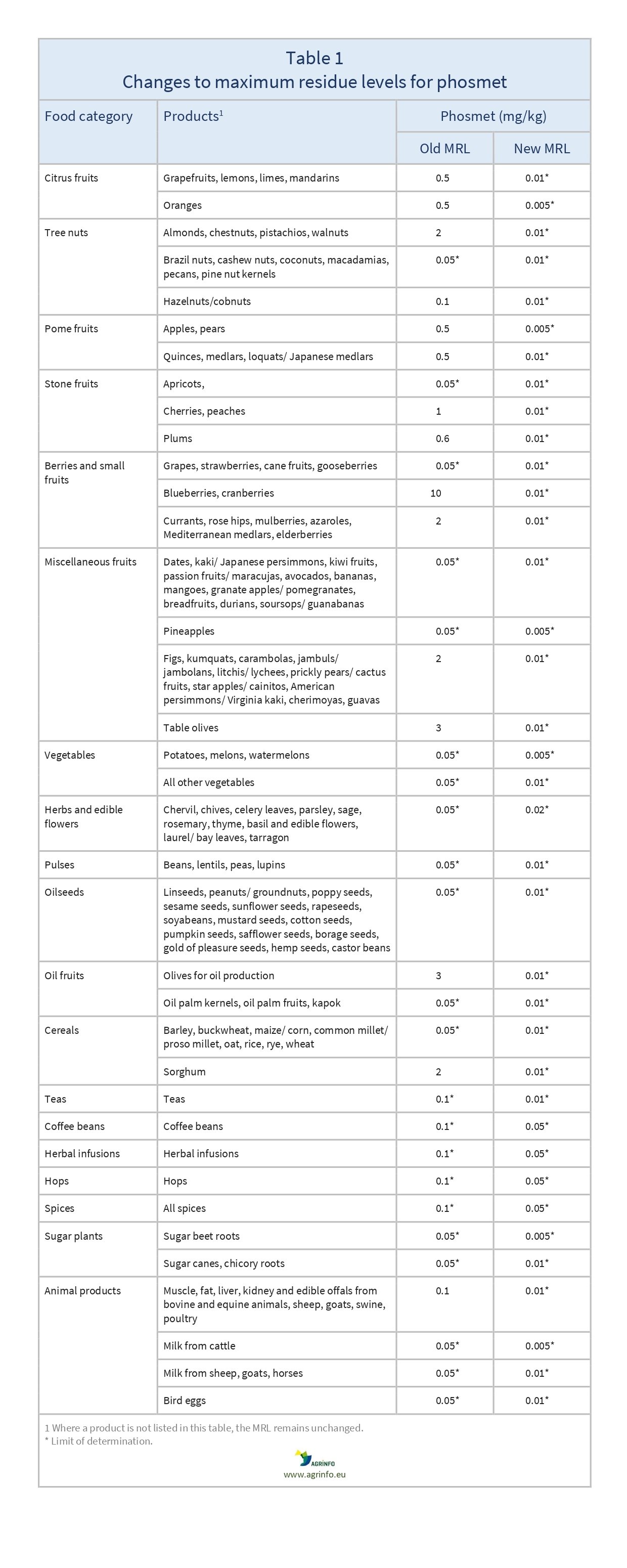Maximum residue levels for phosmet
- Food safety
- Pesticide MRLs
- Pesticides
Summary
On 26 May 2023, the European Commission published a Regulation reducing the maximum residue levels (MRLs) for phosmet to the limit of determination (LOD, the lowest level that can be detected using the most modern and reliable analytical methods). For phosmet these range between 0.005 and 0.05 mg/kg. There are implications for exporters of fruit, tree nuts, vegetables, cereals, teas and coffees, cereals, and animal products.
EU reduces maximum residue levels for phosmet on all products
Commission Regulation (EU) 2023/1029 of 25 May 2023 amending Annexes III and V to Regulation (EC) No 396/2005 of the European Parliament and of the Council as regards maximum residue levels for phosmet in or on certain products
Update
On 26 May 2023, the European Commission published a Regulation reducing the maximum residue levels (MRLs) for phosmet to the limit of determination (LOD, the lowest level that can be detected using the most modern and reliable analytical methods). For phosmet these range between 0.005 and 0.05 mg/kg. There are implications for exporters of fruit, tree nuts, vegetables, cereals, teas and coffees, cereals, and animal products.
Impacted Products
All spices, almonds, American persimmons/ Virginia kaki, apples, apricots, avocados, azaroles, banana, barley, basil and edible flowers, beans, blueberries, borage seeds, Brazil nuts, breadfruits, buckwheat, cane fruits, carambolas, cashew nuts, castor beans, celery leaves, cherimoyas, cherries, chervil, chestnuts, chives, coconuts, coffee beans, common millet/ proso millet, cotton seeds, cranberries, currants, dates, durians, elderberries, figs, gold of pleasure seeds, gooseberries, granate apples/ pomegranates, grapefruits, grapes, guavas, hazelnuts/ cobnuts, hemp seeds, herbal infusions, hops, jambuls/ jambolans, kaki/ Japanese persimmons, kapok, kiwi fruits, kumquats, laurel leaves, bay leaves, lemons, lentils, limes, linseeds, litchis/ lychees, loquats/ Japanese medlars, lupins, macadamias, maize/ corn, mandarins, mangoes, Mediterranean medlars, medlars, melons, mulberries, mustard seeds, oats, oil palm kernels, oil palm fruits, olives for oil production, oranges, parsley, passion fruits/ maracujas, peaches, peanuts/ groundnuts, pears, peas, pecans, pine nut kernels, pineapples, pistachios, plums, poppy seeds, potatoes, prickly pears/ cactus fruits, pumpkin seeds, quinces, rapeseeds, rice, rose hips, rosemary, rye, safflower seeds, sage, sesame seeds, sorghum, soursops/ guanabanas, soyabeans, star apples/ cainitos, strawberries, sunflower seeds, table olives, tarragon, teas, thyme, walnuts, watermelons, wheat
What is changing?
The changes to MRLs for phosmet are summarised in Table 1.
Why?
Phosmet is no longer permitted for use in the European Union. MRLs previously set for phosmet have therefore been deleted and set to the LOD, even on products for which the MRLs were based on CODEX MRLs as the European Food Safety Authority could not rule out harmful effects on human health (EFSA 2022).
Timeline
The Regulation enters into force on 15 June 2023.
The new MRLs will apply from 15 September 2023.
What are the major implications for exporting countries?
Chile and Brazil have raised concerns to the World Trade Organization that the reduction in MRLs will have a significant impact on trade of citrus fruits (WTO 2022).
Recommended Actions
Suppliers to the EU market of fruits, vegetables, cereals, teas and coffees, and animal products should immediately review their current use of phosmet, and should seek alternative solutions where necessary.
The new reduced MRLs will apply to all food on the EU market from 15 September 2023. Food exported to the EU before that date must comply with the new MRLs if it is still on the market after 15 September.
Suppliers and competent authorities should verify that laboratories used to check compliance are able to test to levels of 0.005 mg/kg on apples, pears, pineapples, potatoes, melons, watermelons, sugar beet roots, and milk from cattle.
Background
MRLs are set in accordance with the rules set out in Regulation 396/2005. For information on current MRLs for other substances, please consult the EU Pesticide Residues database.
Resources
EFSA (2022) Review of the existing maximum residue levels for phosmet. EFSA Journal, 20(7): 7448.
WTO (2021) Committee on Technical Barriers to Trade – Meeting on 10–12 November 2021.
Sources
Regulation (EU) 2023/1029
Tables & Figures

Source: based on Regulation (EU) 2023/1029
Disclaimer: Under no circumstances shall COLEAD be liable for any loss, damage, liability or expense incurred or suffered that is claimed to have resulted from the use of information available on this website or any link to external sites. The use of the website is at the user’s sole risk and responsibility. This information platform was created and maintained with the financial support of the European Union. Its contents do not, however, reflect the views of the European Union.
EU reduces maximum residue levels for phosmet on all products
Commission Regulation (EU) 2023/1029
What is changing and why?
As EU farmers are no longer permitted to use phosmet, the maximum residue levels (MRLs) have been reduced to 0.005–0.05. See Table 1 for changes on specific products.
Actions
Suppliers to the EU market of fruits, vegetables, cereals, teas and coffees, and animal products in particular must immediately review their current use of phosmet, and seek alternative solutions where necessary.
Timeline
The new reduced MRLs will apply to all food on the EU market from 15 September 2023. Food exported before that date must comply with the new MRLs if it is still on the market after 15 September.
Tables & Figures

Source: based on Regulation (EU) 2023/1029
Disclaimer: Under no circumstances shall COLEAD be liable for any loss, damage, liability or expense incurred or suffered that is claimed to have resulted from the use of information available on this website or any link to external sites. The use of the website is at the user’s sole risk and responsibility. This information platform was created and maintained with the financial support of the European Union. Its contents do not, however, reflect the views of the European Union.
